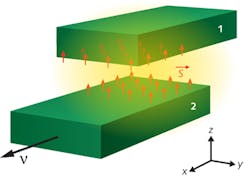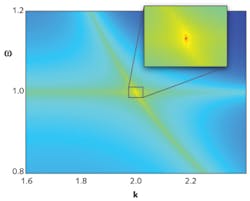Resonators: Moving photonics cause singular Fabry-Perot resonance
ZUBIN JACOB
Every optical engineer is familiar with the Fabry-Perot resonator, which consists of two parallel reflecting surfaces that trap light so that it bounces back and forth between the surfaces. The capture of light in this configuration is widely used in lasers and interferometers. The figure of merit for this light trapping is the quality factor, which is related to the reflectivity R of the mirrors (the closer R is to 100%, the higher the quality factor becomes) and which determines how long the mode lives inside the device.
While this type of resonant configuration has been known for 200 years, our group at the University of Alberta has discovered a unique twist: Once the parallel plates are set in relative motion, the quality factor of the resonance can be enormous, actually approaching a singularity.1
Any resonance arises from a delicate balance of phase and amplitude of the waves in a system. One can engineer either the phase or the amplitude by adjusting the materials and dimensions, but causality requires that both can never occur together for a mechanically static system.
Moving mirrors
The phenomenon we have discovered is unique to a moving photonic system. We considered metallic mirrors moving parallel to each other separated by a nanoscale vacuum gap. For evanescent waves bouncing between these moving mirrors, a perfect phase and amplitude balance arises that can never occur for stationary plates. The most interesting aspect is that every photonic phenomenon in the moving two-plate system will be affected by the existence of such a resonance.
At the heart of this resonance is the concept of a negative-frequency photonic mode. This is an intriguing phenomenon that occurs in moving media due to extreme Doppler shifts. For observers in relative motion, frequencies of light are shifted depending on the velocity. If the velocity of motion is so high that it exceeds the phase velocity of the photonic mode, then the light appears to take a negative frequency for the moving observer.
Many phenomena are reversed in this negative-frequency scenario; for example, a light-absorbing medium can spontaneously emit photons. This electromagnetic energy comes at the expense of a decrease in the mechanical energy of motion, or the work done to keep the body moving at constant velocity.Vacuum friction
An interesting phenomenon about vacuum fluctuations is closely tied to the moving-plate system. Similar to the Casimir force that pulls two plates together when only a very small gap is separating them, there exists a drag force that slows down the moving plate. This frictional force mediated by vacuum occurs from the coupling of the zero-point-charge fluctuations in the two plates.
We have predicted a giant increase in the vacuum friction due to the existence of this photonic mode. In essence, vacuum behaves like a viscous jelly at the singular resonance, causing a huge frictional force between the two plates.
The gap sizes needed for the phenomenon are 10 nm, which is not difficult to achieve for parallel plates. The evanescent surface waves are readily available in low-frequency plasmonic media such as terahertz degenerately doped semiconductors and graphene.2,3 However, the formidable challenge is the velocity of motion, which needs to be on the order of the Fermi velocity of electrons in the metal, or about one hundredth of the speed of light.
As a result, we are thinking of innovative approaches using sound waves and water waves to observe this resonance, which is a kinematic phenomenon related to waves in general. This resonance also offers intriguing possibilities for cooling and stopping moving media by sudden emission of large amounts of electromagnetic energy.
REFERENCES
1. Y. Guo and Z. Jacob, Opt. Express 22, 21 (2014); doi:10.1364/OE.22.026193
2. A.J. Hoffman et al., Nat. Mater. 6, 946 (2007).
3. A.I. Volokitin and B.N. J. Persson, Phys. Rev. Lett. 106, 094502 (2011).
Zubin Jacob is an associate professor of electrical and computer engineering at the University of Alberta, Edmonton, AB, Canada; e-mail: [email protected]; www.ece.ualberta.ca/~zjacob.

